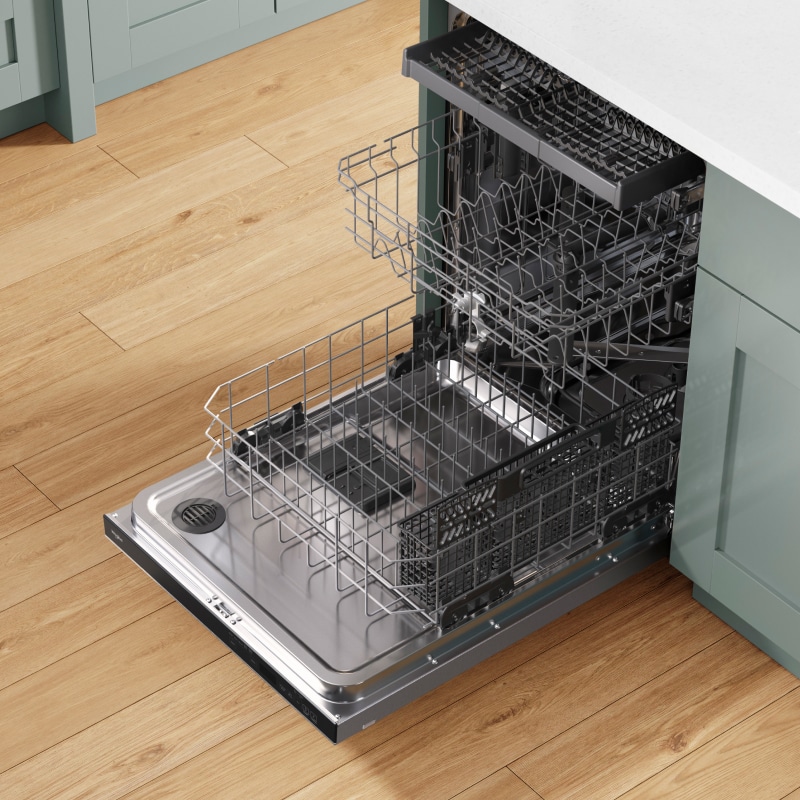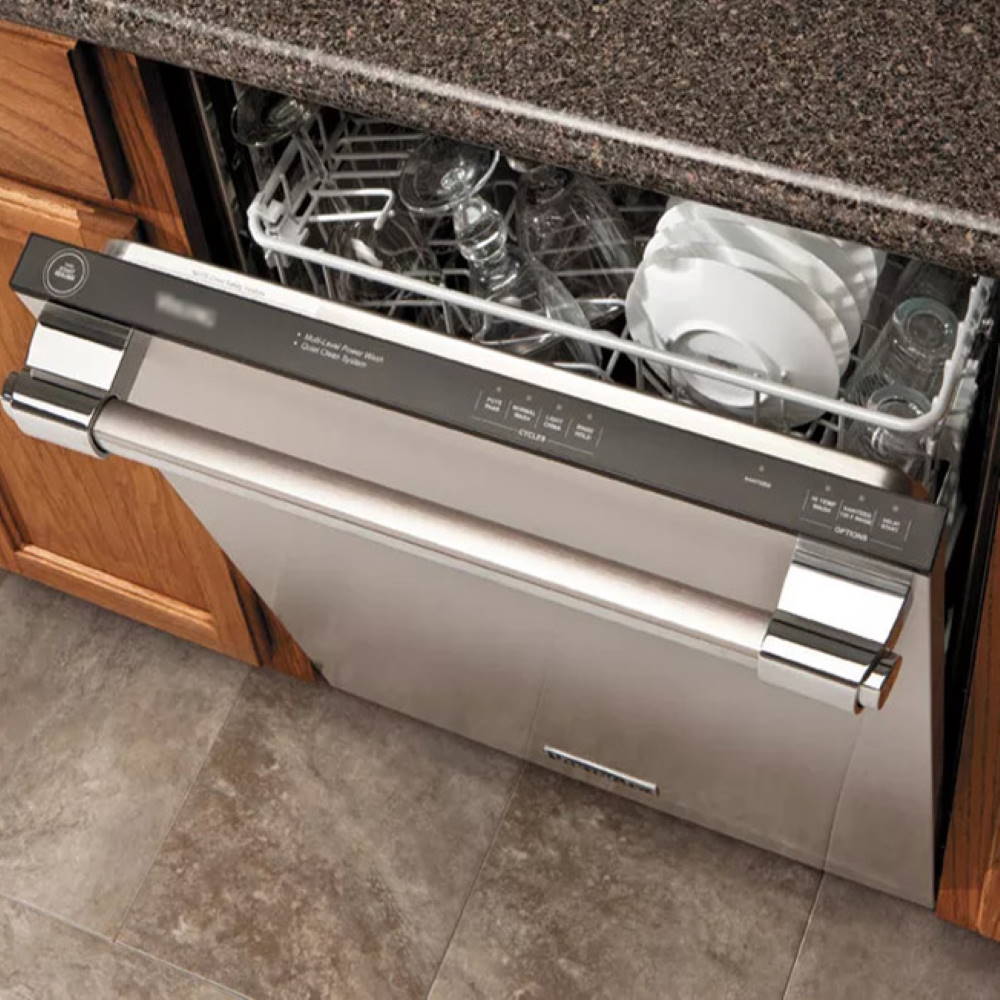Step-by-Step Guide to Manually Draining Your Dishwasher
How to fix a dishwasher that won’t drain? Encountering a dishwasher that won’t drain can be frustrating. Here’s a step-by-step guide to tackle this issue yourself.
- Prepare: First, clear the dishwasher of dishes and racks. Turn it off and unplug it. Place towels around to catch spills.
- Remove Water: Use a cup or scoop to bail out water into a sink or bucket. For remaining water, use a towel.
- Clean the Filter: Check the filter at the dishwasher’s base. Remove, rinse, and scrub it with hot, soapy water. Clear any debris below the filter area.
- Bicarbonate and Vinegar: Try a mix of baking soda and vinegar in the tub. Wait 20 minutes. If water drains, run a hot cycle.
- Inspect the Hose: Check under the sink for the drain hose. Look for kinks or blockages. Clear any obstructions found.
- Drain Valve Check: Ensure the valve at the dishwasher’s base moves freely.
- Test Cycle: Run an empty cycle to see if the issue is fixed.
Always ensure the filter is clean to avoid future drainage problems. If these steps don’t work, professional help may be needed.
Troubleshooting the Filter: Cleaning and Maintenance
Before you address the drain valve or hose, check the filter. The filter traps food, grease, and debris. A clogged filter can block water from draining. Start by locating the filter. This is often at the dishwasher’s base. Remove the filter. For most dishwashers, twist or pull it out. Check your model’s manual if you’re not sure how. Next, clean the filter. Use hot, soapy water and a soft brush. Scrub gently but thoroughly. Then, rinse the filter well under running water.
After cleaning, check the sump. This is where the filter sits. Remove any debris or food scraps there. Make sure nothing blocks the drain path. Once clean, replace the filter. Make sure it fits snugly in place.
For regular maintenance, clean your filter monthly. This helps prevent clogs and maintains your dishwasher’s efficiency. A clean filter can improve water flow and enhance the dishwasher’s performance.
Remembering to regularly check and clean your dishwasher filter is a simple yet impactful step towards ensuring your appliance functions properly and avoids drainage issues.
The Bicarbonate of Soda and Vinegar Solution
How to fix a dishwasher that won’t drain? If your dishwasher still holds water after the previous steps, try this natural mix. Combine equal parts of bicarbonate of soda and vinegar. Pour it into the dishwasher tub. Wait for about 20 minutes. This mixture may dissolve the clog causing the drainage issue. After the wait, check if the water starts to drain. If it does, run a hot cycle to flush out residue. This solution is safe and gentle on dishwasher parts. But remember, do not use harsh chemicals like drain cleaners. They can harm your dishwasher’s interior.
Inspecting and Unclogging the Drain Hose
After the filter, the drain hose is a common culprit when dishwashers fail to drain. The hose may kink or clog, impeding water flow. To inspect the drain hose, look under your kitchen sink or remove the bottom panel of your dishwasher. If you find kinks, straighten them carefully. Unkinked hoses still might have blockages. Disconnect both ends of the hose. Use a long brush to remove any debris inside. Reattach the hose securely, being careful not to cause new kinks.
Once you’ve resolved any hose issues, run a test cycle. Your dishwasher should now drain correctly. Keep the drain hose clear to prevent future drainage problems. If these steps don’t clear the water, the problem may lie elsewhere, and you might need professional help.
Checking the Drain Valve for Proper Operation
Once you’ve dealt with the filter and the drain hose, the next step is to check the drain valve. This valve plays a crucial role in allowing water to exit your dishwasher. A stuck or malfunctioning valve can cause water to remain in the machine. To check the drain valve, follow these simple steps:
- Locate the Valve: Find the drain valve at the bottom of your dishwasher. It is usually near the motor.
- Inspect for Blockage: Look for debris that might be causing a blockage. Clear any obstruction that you find.
- Test the Valve: Push on the valve to see if it moves freely. It should not be stuck or hard to move.
- Listen for Clicking Sounds: As your dishwasher runs, listen for the valve. It should click when it opens and closes during the cycle.
If your drain valve is not operating correctly and you cannot fix it, it may need to be replaced. However, if it still doesn’t work after you’ve checked and tried to clear it, it’s probably time to seek help from a professional.
Make sure to perform regular checks on the drain valve to ensure proper function. This can save your dishwasher from future drainage issues and prolong the life of your appliance.
Remember to always turn off and unplug your dishwasher before attempting any repairs or maintenance to avoid the risk of electrical shock or damage to the machine.
Preventive Maintenance: Regular Cleaning and Care
How to fix a dishwasher that won’t drain? Preventive maintenance is key to keep your dishwasher running smoothly. It’s not just about fixing problems as they arise, but also about preventing them in the first place. Regular cleaning and upkeep can extend the life of your appliance and ensure it performs at its best. Here’s how you can implement a routine care plan.
Develop a Cleaning Schedule
Create a monthly checklist to clean your dishwasher. This includes wiping the door seals, checking for food particles, and rinsing out the filter.
Use Appropriate Cleaning Agents
For routine cleaning, use mild detergents or a vinegar solution. Avoid harsh chemicals that can damage your dishwasher.
Check and Clean the Spray Arms
Ensure the spray arms are not blocked. Clean them regularly to prevent clogs which can affect your dishwasher’s efficiency.
Run Empty Cycles with Vinegar
Occasionally run a cycle with just vinegar. This helps to remove grease and limescale buildup that can cause odors.
Keep the Drain Hose Clear
Regularly check the drain hose to ensure it’s not kinked or blocked. Your dishwasher can’t drain properly if the hose is obstructed.
Inspect and Clean Seals and Gaskets
Check the seals and gaskets for wear and tear. Clean them to maintain a proper seal and prevent leaks.
By taking these preventive steps, you’re not just avoiding immediate problems like a dishwasher that won’t drain, but also investing in the longevity and efficiency of your appliance. This saves you money and inconvenience in the long run. If you maintain it well, your dishwasher can serve you flawlessly for many years.
When to Call a Professional: Understanding Dishwasher Repair and Replacement
How to fix a dishwasher that won’t drain? When you’ve tried all the DIY fixes and your dishwasher still won’t drain, it’s time to consider professional help. Here are some guidelines on when to call a technician and weigh the options between repair and replacement.
Recognizing the Need for Expertise
If you’ve cleaned the filter, flushed the drain hose, and checked the drain valve with no luck, an expert may find issues you’ve missed. This includes complex problems like motor faults or electrical issues that require specialized knowledge.
Evaluating the Cost of Repair
Before calling a professional, think about the age and condition of your dishwasher. If it’s relatively new, a repair might make sense. Older machines might not be worth the investment, especially if they need costly repairs.
Warranty and Manufacturer Support
Check if your dishwasher is still under warranty or manufacturer’s coverage. If so, you might get free or discounted repairs. Always check your warranty terms before deciding on a course of action.
Considering Replacement Over Repair
Sometimes, replacement is the better choice. New dishwashers often offer more efficiency and better features. If your current dishwasher is old or the repair is expensive, upgrading may be a smart move.
How to Decide
To decide between repair and replacement, compare costs. Get quotes for repairs and compare them to the price of new models. Also, consider how much longer your current dishwasher might last after the repair.
Remember, proper maintenance can extend the life of your appliance. Regular upkeep helps avoid frequent calls to a technician. But when issues go beyond simple fixes, seeking professional help is the smarter and, often, the only option.
Preparing Your Dishwasher for Transportation: Drainage Tips for Moving
When moving a dishwasher, the right preparation is essential. Start by draining all water to avoid messes and damage. Follow these steps to prepare your appliance for the move.
- Empty the Dishwasher: Make sure your dishwasher is free of dishes.
- Unplug and Drain: Disconnect from power and manually drain residual water using the steps from the manual draining guide above.
- Secure the Door: Tie or tape the door to prevent it from opening during transit.
- Protect the Exterior: Wrap the dishwasher in blankets or bubble wrap. This helps shield it from bumps and scratches.
- Stabilize Internal Components: If possible, secure the racks and spray arms inside.
- Keep the Hose Accessible: Attach the hose to the dishwasher or keep it in a labeled bag.
How to fix a dishwasher that won’t drain? Remember to avoid tilting your dishwasher. This can cause remaining water to leak onto sensitive electronic parts. Once you’ve reached your new home, install and test your dishwasher to ensure it’s functioning properly. Proper preparation reduces the risk of issues and helps a smooth transition to your new space.








